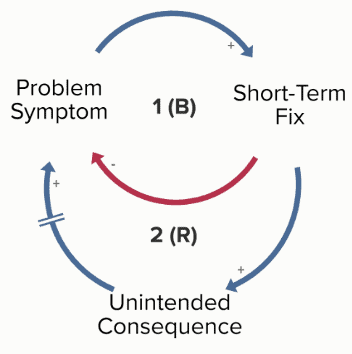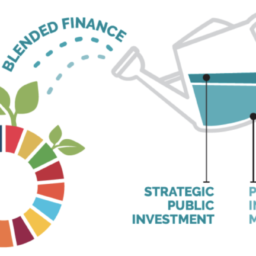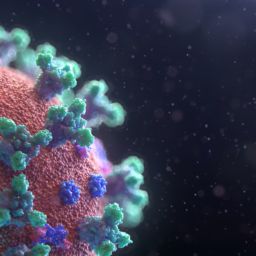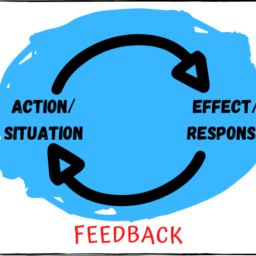Author: Jenna White and Rich Fromer
Last week, we introduced the idea that in a complex system it is particularly hard to find the cause and effect relationships that are separated in time (delayed) and space (physical distance). One way to explore these more complex relationships – and to understand how they make it difficult to solve a development problem – is to construct a causal loop diagram (CLD). These diagrams lay out factors and their cause-effect relationship to other factors influencing the problem. There are many existing resources on constructing a CLD, including our User’s Guide and our courses .
One of the benefits of constructing a diagram is that it allows you to identify “archetypes” or common patterns of behavior that we see repeated often in complex systems. One archetype that is frequently found in international development is called “Fixes that Fail.” It is tempting to put in solutions that fix a problem in the short term.
However, while our short term “fix” may improve the problem at first, it often also has unintended effects that are delayed or that show up somewhere else in the system. Some of these effects may be positive, but some may be negative – possibly making the situation worse than before our intervention. For example, a quick fix solution to a water shortage might be to drill new wells. However, in the long run this will lower the water table further, causing even worse water shortages in the future.


We have seen a few examples of possible fixes that fail in some of the responses to the current pandemic as well. For example, in a much needed and important immediate response to the direct impact of COVID-19 in developing countries, many donors have shifted funding away from their longer-term programming (things like WASH, livelihoods, or human rights).
While the emergency response is absolutely necessary to save lives, the long-term effect will reduce local civil society ability to support marginalized communities (to reduce food-borne illness, increase household income or prevent domestic violence) who will then be more vulnerable to future pandemics or other shocks.

Again, in an emergency like this pandemic, saving lives now is crucial, but are there things we could be doing when faced with a fix that fails like this? Given that these happen so often, there are some strategies that we know are more effective. Those include:
- Raise awareness of the unintended consequences of the quick fixes to make better choices and to mitigate negative effects
- Compare different quick fix solutions for fewer unintended consequences
- Implement quick fixes and long-term solutions simultaneously
- Identify the underlying problem (root cause) and not only the symptoms
If we know that some fixes fail and what strategies can work to improve our results, why do we keep using them in our work? We tend to lean on those easy fixes because of our own perceptions, past experience and assumptions about how the system works (our “mental models”). We can easily imagine and understand the thought processes that lead to fixes that fail. For example, “this solution has worked in the past,” or “we need to solve this problem now, we can deal with the consequences later.”
In short, if we fail to take a systems lens, thinking through the non-obvious and non-linear effects, we may inadvertently be making things worse. So how can we ensure that we’re not just playing development whack-a-mole? We suggest starting by diagramming the current situation (as-is, pre-intervention). That diagram can be used to identify root causes and also to model what may happen as a result of your proposed intervention. Done at the program design stage, this process can help practitioners identify, and mitigate – or ideally avoid – negative unintended effects of our work.



